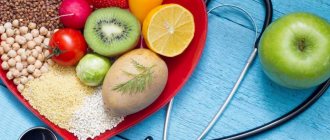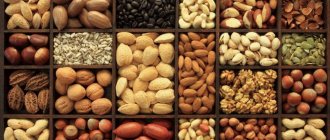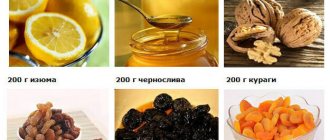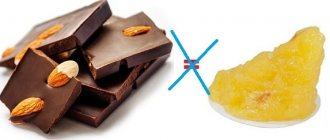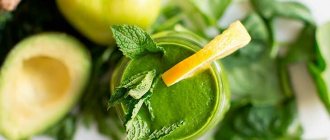In this article we will tell you:
- Functions of fats
- Classification of fatty acids
- Fat burning
- Omega-3 and Omega-6 PUFAs
- Daily fat requirement
- Healthy and unhealthy fats
- Fat deficiency
- Excess fat in the diet
Fats
― essential food components that perform a huge range of multidirectional functions in the human body. From a chemical point of view, this is a combination of the polyhydric alcohol glycerol and three fatty acids - and the type, length of carbon chains and types of bonds between carbon atoms will largely determine the energy value of the latter.
What is the daily requirement for this class of organic compounds? What to give preference: products of plant or animal origin? Let's figure it out.
Functions of fats
- Energy
- indeed, the power plants of cells, tirelessly producing energy, are capable of using not only carbohydrates as raw materials - although, to be honest, they often prefer glucose.
The use of fats as metabolic firewood is a very beneficial process and provides long-term saturation at all levels of the body’s functioning.
After triglyceride molecules have been broken down into their constituent components by digestive enzymes and absorbed into the epithelial villi of the inner lining of the intestine, fatty acids and glycerol are sent to the mitochondria, where they are “burned” with the subsequent formation of energy in the form of ATP.
Just think about it: if 1 glucose molecule is capable of producing only 38 ATP molecules (and this takes into account that all the stars in the sky will converge and oxygen will be supplied on time - otherwise, the process will be limited to 2 ATP molecules and the formation of lactic acid). At the same time, such an efficiency of fat is equivalent to several hundred ATP molecules - everything, we repeat, depends on the composition of fatty acids.
However, there are some limitations: in particular, the transformation of glucose does not require the presence of mitochondria, small energy plants - this is perhaps the only cascade of catabolic reactions (that is, breakdown processes) that occurs in the cytoplasm of cells. In addition, the existence of the so-called “barrier organs,” which include, for example, the brain, makes it impossible (due to the insurmountable border between the blood and the tissue itself) for fatty acids, transported in complex with large molecules by plasma proteins, to enter them from the vessels.
- Structural
- first of all, these are components of cell membranes. Phospholipids (along with protein molecules) participate in the formation of a clearly defined boundary between the cytoplasm (that is, the internal contents) and the extracellular environment.
- Regulatory
: Many biologically active compounds are formed from them. Signaling molecules, steroid hormones, and even individual vitamins are all lipophilic in nature.
- Shock absorbing
- This is a kind of airbag that protects internal organs from mechanical damage.
Fats and diet. Daily norm for weight loss.
Details
Hello, dear readers of dietalegko.com, in this article we will talk about fats, their types, how to distinguish between good and bad fats, and how they affect the weight loss process in general.
We will understand the issues related to the consumption of fat when losing weight, and we will learn to calculate the individual rate of consumption of these substances per day during the diet.
I want to start with another personal story of my weight loss, where I’ll tell you about the mistakes that I made and that prevented me from achieving my goals.
Having made the decision to lose weight, I reviewed my diet and the first thing I did was remove all kinds of fatty foods. I believed that it was necessary to exclude them as much as possible. I ate exclusively vegetables, low-fat dairy products and allowed myself some fruit. At that time, I considered meat and fish products unsuitable for weight loss, since they contain fats. Perhaps you recognize yourself here too.
After only a week of my diet, I began to feel tired and irritated, and after two weeks my hunger was ravenous. I didn't understand why this was so? Why didn't everything I ate make me feel full? But it turns out it’s all about the fats that I threw out of my menu.
If you are faced with a similar problem, reconsider your diet and especially pay attention to the fat content in your menu, what foods you use them with and in what quantities.
I recommend paying attention to these articles, they complement this topic well:
- Basic protein foods and their benefits for weight loss.
- Simple and complex carbohydrates. Product table.
- Main sources of protein for humans.
- Carbohydrates you shouldn't eat on a diet.
In order to help you understand the topic of fats during weight loss, I will provide you with information based on my personal research and observations, obtained by studying books on weight loss and the Internet.
It turns out that fats are simply necessary when losing weight, and their amount is individual for each person. I wish someone had told me this earlier.
The benefits of fats for the human body when losing weight:
- - they are a source of energy;
- - participate in the formation of brain neurons;
- - ensure the functioning of the immune system;
- - stimulate the release of bile during digestion;
- - promote the absorption of vitamins and microelements;
- — calcium absorption in bones also occurs in combination with fats;
- - regulate metabolic rate;
- — saturate the body and thereby ensure the absence of hunger, which in turn does not provoke a person to overeat.
How to calculate your daily fat intake when losing weight.
Nutritionists say that when losing weight, you need to reduce your fat intake to 80 g per day. And the best solution to this issue is to calculate the individual norm of fat consumed. There are several ways to help make calculations.
1st method.
For heights up to 165 cm, subtract 100; If your height is 166 - 175 cm, subtract 105; Height over 175 cm, subtract 110.
The resulting calculation results will correspond to your norm of fat consumed per day when losing weight in grams.
2nd method.
I find this method more effective because you can eat different amounts of fat each day. This amount is calculated using each person's individual minimum daily intake and does not exceed 80 g of fat per day.
The minimum individual amount of fat can be calculated by multiplying your ideal weight by 0.8.
You can find out your ideal weight using Brocca's formula by following the link.
For example, your ideal weight is 65 kg. 65* 0.8=52 g
Your minimum intake of fat when losing weight is 52 g. If you create your daily diet with the amount of fat in the range of 52-80 g, this will be enough for comfortable weight loss, good health and the absence of hunger.
But the benefits of fat are possible only if it is consumed correctly.
Good and bad fats.
What fats to consume when losing weight, and which ones are better to limit or completely exclude from your diet.
Conventionally, these substances can be divided into two types:
- vegetable
- and animal origin.
And in terms of its composition:
- to those saturated with fatty acids
- and unsaturated.
Saturated fats remain solid at room temperature. To melt their contents, they should be heated well. It is for this reason that when they enter the human body in large quantities, they cause diseases of the cardiovascular system, causing an increase in cholesterol in the blood. In addition, consuming saturated fat leads to obesity.
Saturated fats are found in meat, fish, eggs, and dairy products (lard, margarine, butter, cream, lard, etc.). Very often they are used in fast foods, various baked goods, and confectionery products.
Therefore, people who want to stay healthy and slim try to exclude such foods from their diet. Meat, fish, eggs and dairy products are important for the healthy development of the human body, so they need to be consumed in a certain amount and choose less fatty varieties.
Unsaturated fats are found in vegetable oils (sunflower, olive and coconut oils, as well as nuts and seeds). These fats are considered one of the most beneficial for the human body during various diets, since their insufficient intake harms the functioning of the gastrointestinal tract and nervous system, leads to weakened immunity, memory impairment and the development of atherosclerosis.
Read: - Fat-burning foods that help you lose weight.
To summarize, I want to emphasize that fats must be present in your daily diet during weight loss. The main thing is to be able to understand foods that contain healthy (unsaturated) and harmful (saturated) fats, then your weight loss will be effective and will not harm your body.
When losing weight, fats should be consumed in the form of vegetable oils. Use olive, sunflower, and flaxseed oil for dressing salads and preparing dishes. You also need to consider getting fats through dairy products, meat, eggs and fish.
Use low-fat varieties of these products in your diet, since the breakdown of 1 gram of fat releases as many as 9 kilocalories. If these kilocalories are not consumed, they are deposited in the body in the form of fat reserves in the liver, subcutaneous fat, internal organs and other fat depots.
The diet of a person losing weight should not contain products such as margarine, butter, various spreads and lard. You also need to exclude baked goods, confectionery, fast food, fatty sausages and fatty meats and fish.
When creating your diet menu, do not forget about the quality and quantity of fat consumed in your daily diet. Remember that a low-fat diet leads to chronic hunger and can cause serious metabolic disorders.
We wish you to be healthy and slim!
Related materials:
- Which foods contain which vitamins and minerals.
- Glycemic index. Theory and tables, influence on weight loss.
- Blood sugar. Influence on the process of losing weight.
- What foods should you not eat when losing weight?
We recommend reading
Tags: fats, daily intake
Add a comment
Comments
1 Alla Lyapunova 03/30/2018 16:17 You can’t completely exclude fats from your diet... you should have both saturated and unsaturated fats every day. + in addition, it’s not bad to drink 3 capsules of omega 3 daily (I replace it with one capsule of triple Evalar omega), this is a very important supplement for the body.
Reply | Reply with quote | Quote
Update list of comments RSS feed of comments for this entry
Classification of fatty acids
- Short chain
(short-chain fatty acids) - are formed in the large intestine under the influence of bacteria inhabiting it from undigested food components - in particular, carbohydrates. They, as studies note, are able to reduce the synthesis of cholesterol in hepatocytes and neutralize to some extent inflammatory reactions, thus preventing the development of fatty liver.
In addition, one of their representatives, butyrate, obtained during the fermentation of dietary fiber, stimulates the growth and reproduction of colonies of bifidobacteria and lactobacilli. It also activates thermogenesis - heat production - and energy expenditure, thus promoting weight loss and playing a significant role in the context of preventing insulin resistance and other disorders of carbohydrate metabolism.
Propionic acid, another short-chain fatty acid, is not only produced by bacteria in the intestinal lumen, but also comes from the outside in certain foods, especially yogurt and cheese. This is the raw material that is included in hepatocytes in gluconeogenesis - that is, in the synthesis of glucose directly inside the human body.
- Medium chain fatty acids
found in some foods: coconut oil, cream and milk;
- Long chain fatty acids
have more than 18 carbon atoms. In particular, this category includes the well-known omega-3 and omega-6 polyunsaturated acids, which we will discuss separately below.
Fat burning
As previously noted, fats, although not a 100% universal source of fuel for cells, are nevertheless a very beneficial substrate for energy production. Conventionally, three stages can be distinguished:
- Oxidation of fatty acids in mitochondrial furnaces
— the presence of the latter is a mandatory element in the context of lipid metabolism.
This process is preceded by the breakdown of triglycerides (synthesized in hepatocyte factories or coming from outside, with food) into polyhydric alcohol glycerol and three fatty acids. The reaction is catalyzed by lipase, a hormone-sensitive enzyme secreted primarily by pancreatic cells.
Its activity is stimulated
:
- Thyroid hormones
- T4 (thyroxine) and T3 (triiodothyronine).
- Glucagon
- secreted by the islets of Langerhans, localized in the pancreas. Its task is to raise blood glucose levels and thus prevent the development of hypoglycemia.
- Adrenaline
— is formed by the adrenal medulla under the influence of stress factors, when the human body is in dire need of energy (primarily to carry out the “fight or flight” reaction).
On the other hand, lipase activity is inhibited by:
- Insulin
(This explains the violation of fat utilization in diabetes mellitus, which is accompanied by the infiltration of fatty acids into various organs with the subsequent development of their obesity).
- Chemical compounds similar to it - for example, lectins
as part of wheat.
- acetyl-CoA formed as a result of the oxidation of fatty acids is sent along the path of further energy production.
, which again occurs in mitochondria: on the respiratory chain built into their inner membrane.
We recommend
“Metabolic syndrome: causes, symptoms, treatment and prevention” Read more
In addition to hormone-controlled lipase, fatty acid oxidation requires
:
- Vitamin B5
- pantothenic acid, concentrated in:
- chicken fillet;
- offal;
- some legumes;
- cauliflower;
- eggs;
- nuts
- Sufficient supply of magnesium to the body
.
- Active forms of vitamins B2 and B3
.
- Carnitine
- carries out the transfer of fatty acids from the cytoplasm to the place of their oxidation, into mitochondria.
- Alpha lipoic acid
.
Omega-3 and Omega-6 PUFAs
Omega-3 and omega-6 polyunsaturated fatty acids are essential food components necessary for the normal functioning of the body during all age periods. “Polyunsaturated” is a term that characterizes the chemical structure and means the presence of double bonds or bonds in the composition of their carbon chains.
“vitamin F” was used to designate essential fatty acids - that is, those that the body is not able to form on its own.
- this once again emphasizes the importance of the functions mediated by them.
This category, in particular, included linoleic and linolenic acids
- omega-6 and omega-3 fatty acids, respectively. From the first, arachidonic acid is synthesized in the cells of our body - a precursor of tissue hormones, which largely determine the course and nature of inflammation. The second is the raw material for the production of eicosapentaenoic and docosahexaenoic acids (EPA and DHA).
It must be said that our cells have learned to produce both EPA and DHA on their own, but this process is not only labor-intensive and time-consuming, but also largely depends on the functional characteristics of the corresponding regulatory genes.
Docosahexaenoic acid is especially important for children: this is evidenced by the fact that it largely predominates in the gray matter of the brain, and also affects visual acuity, being part of the lining of the retina.
Supplementation with key omega-3 PUFAs has been associated with improvements in children's visual memory, concentration, and has even been used as part of the treatment for attention deficit hyperactivity disorder. In addition, scientists increasingly believe that there is an undeniable relationship between the concentration of these long-chain fatty acids in the blood plasma and red blood cell membranes with the intellectual abilities of the child.
Considering that polyunsaturated fatty acids are a component of all cell membranes (and cells of the immune system are no exception), their relationship with the implementation of the body’s protective functions is also clear.
The results of recent studies are also interesting: it turns out that an increase in the content of omega-3 among the components of the bilipid layer of the selective boundary at the junction of the cellular and extracellular environments is one of the key factors influencing the conduction of chemical signals (synapses) from receptors to the nucleus in lymphocytes - cells that in the process of their differentiation, they provide not only the production of antibodies and immune memory mechanisms, but are also an important element of the cellular component of immunity.
In addition, in the nucleus they directly influence the expression of genes, the products of which suppress the formation of pro-inflammatory signaling molecules (for example, interleukin-1).
EPA and DHA inhibit the enzyme that provides the formation of pro-inflammatory molecules: prostaglandins, leukotrienes, thromboxane, which are involved in increasing vascular permeability with the subsequent development of edema, as well as irritating nerve endings and thereby participating in the formation of sensations of pain and itching.
Increased attention to this class of compounds is explained by the fact that any shift in the functioning of the immune system, leading to an imbalance among its police cells, mediates the development of not only various types of autoimmune and allergic diseases, but also largely affects oncogenesis, as well as the progression of atherosclerosis.
Researchers rightly believe that the evolutionary process was partly mediated by the diet of our ancestors: so, in their opinion, hundreds of years ago the ratio between omega-6 and omega-3 PUFAs was equal and amounted to 1:1. Today, this ratio has shifted towards 20:1 - impressive, isn’t it?
Such concern, it must be said, is very justified, given all the previously listed effects of omega-3 fatty acids. You can also add regulation of the lipid spectrum (increasing “good” cholesterol in HDL and reducing “bad” cholesterol in LDL and VLDL), inhibition of platelet aggregation and hypotensive effects.
Study
: Omega-3 in children's practice, Long-chain polyunsaturated fatty acids of classes ω-3 and ω-6 as an essential nutrient in different periods of childhood
How much fat to eat to lose weight
A woman's diet should consist of 20 percent fat. The rest is taken up by proteins and carbohydrates. Healthy fats can be obtained from various foods: olive oil, pork, hazelnuts, cod liver, walnuts and pine nuts, almonds, bacon, soft cheeses and even chocolate.
Calculating your daily fat intake is very simple. First, determine your optimal weight. To do this, subtract 100 from your height (in centimeters). If your height is above 165 centimeters, subtract 105; for 175 – 110. Then decide on the bones. If the bone is wide, 10 percent must be added to the resulting amount. If thin, subtract 10 percent. We multiply the resulting figure by 0.8 and get the amount of fat in grams.
If you follow the daily norm, the body will regularly use its accumulated fat reserves to maintain energy and performance. By reducing the daily dose, we will get negative consequences. Firstly, fat-soluble vitamins (D, E, A, K2) will no longer be absorbed from foods. They strengthen our immunity, contribute to the proper course of pregnancy, help absorb calcium, and are responsible for the formation of the skeletal system. A lack of fat will also cause the body to lack omega-3 fatty acids. This will negatively affect the condition of the skin, hair, mood, lead to exhaustion during pregnancy and the development of postpartum depression.
The table will help you not to go beyond the daily norm. Make a list of your most commonly consumed foods. See how much fat is contained in 100 grams of each. Based on this data, create your diet.
Daily fat requirement
In general, determining the amount that would account for the daily share of fat in the diet largely depends not only on the type of diet followed, but also on gender, age, and individual characteristics. In the context of the latter, it is impossible not to mention the total decrease in the production of lipase by the pancreas (the enzyme that actually ensures the processes of chemical breakdown of this class of compounds), as well as problems with bile outflow that are often encountered in the practice of every nutritionist. All this creates certain difficulties in the mechanisms of lipid absorption, even if they are optimally supplied with food.
Speaking about the average need, you can use, for example, this formula:
Amount of fat in the diet = 1.5 * weight in kg
(In this formula, it is necessary to multiply the coefficient by the optimal body weight, that is, without taking into account excess weight, if present)
Why does the female body love fats?
The human body receives the maximum amount of energy from fats and carbohydrates. But men and women have different priorities in this matter. The male body has a higher respiratory coefficient. Therefore, men break down carbohydrates faster. This is especially noticeable during physical activity. Women have a lower respiratory quotient, so the body can more easily cope with fats and draw from them the energy necessary for life.
Of course, this is not the only reason why women are drawn to fat. The fact is that if the female body is given the required amount of fat, the changes will be visible to the naked eye:
- It will become easier to diet. Fats provide pleasant satiety (not to be confused with overeating) and normalize blood glucose levels. Therefore, it becomes easier to control yourself and not overeat. In addition, overall well-being improves, chronic fatigue and lethargy disappear.
- The skin will be smooth, silky and glowing. Your nails will become noticeably stronger. You will also forget about hair loss and split ends.
- The feeling of cold will go away. Women who do not have enough fat in their bodies freeze even in the warm season. They begin to experience disturbances in the heat exchange process.
- Memory and concentration will improve, and vision will become sharper.
- It will become easier for you to endure stressful situations, depression will bypass you.
As you can see, there are many benefits from fats. And the female body understands this very well, so it begins to demand those foods that contain fats.
Healthy and unhealthy fats
“Healthy” and “harmful” fats is a definition equivalent in its incorrectness to the division of hormones into “male” and “female”. Perhaps the only exception is trans fats - their use is contraindicated not only for patients on treatment protocols, but also for people in general who care about the quality and health of their body.
Fats can be divided into saturated and unsaturated
- it all depends on the nature of the chemical bond (single or double/triple) between the carbon atoms in the fatty acids they contain. The former, as a rule, are concentrated in products of animal origin, the latter - in plant origin.
Animals are traditionally considered less healthy, but this does not mean the need to completely eliminate them from the diet: the saturated fatty acids they contain are components of cell membranes. This is why meat, eggs and milk are definitely not foods to be afraid of.
You should also make sure that you have sufficient consumption of fatty fish: tuna, mackerel, herring - American protocols recommend including them in your diet at least 2 times a week. Omega-3 polyunsaturated fatty acids, which these foods are rich in, are essential for newborns: they account for up to 35% of the dry weight of the brain.
It is not surprising that their active reserves are formed in the fetal body by the third trimester, and then, after birth, they serve as a necessary factor for the normal differentiation and maturation of brain neurons.
In general, given the huge preponderance in favor of pro-inflammatory omega-6 fatty acids, which is inevitable in the realities of modern lifestyle and nutrition, still try to control and minimize this imbalance. Below are examples of products in which the main representatives of polyunsaturated fatty acids are concentrated.
Omega-6 PUFA content
- Linoleic acid
concentrated in
:- Sunflower oil.
- Pistachios.
- Sesame seeds.
- Pumpkin seeds.
- Corn and soybean oils.
- Arachidonic acid is found in
:
- Butter.
- Offal.
- Pork fat.
- Eggs.
Omega-3 PUFA content
- Alpha-linolenic acid
rich
:- Linseed oil.
- Pumpkin seeds.
- Walnuts.
- Soybean oil.
- Rapeseed oil.
- Purslane.
- Eicosapentaenoic acid
(EPA)
and docosahexaenoic
(DHA
) acids can be found in
:- Salmon.
- Mackerel.
- Cod liver.
- Tuna.
- Seafood.
- Trout.
Fat consumption per kilogram of weight[edit | edit code]
"A Sports Diet Guide"
Registered Dietitian Renee McGregor, 2016
Contrary to popular belief, not all fats are harmful to humans. Read more:
Harmful and healthy fats Moreover, a certain amount of them helps to absorb fat-soluble vitamins, and serves as a source of fatty acids that a person is not able to produce on his own. These nutrients play a vital role in the functioning of the body.
However, consuming too much of one particular type of fat—namely, saturated fat—raises cholesterol levels, which in turn contributes to heart disease. Saturated fats are found in butter, lard, sweet pies, muffins, cakes, cookies, fatty parts of meat, sausages and bacon, cheese and cream. These types of foods also contain trans fats, which are often found in processed foods. They should be kept to a minimum and choose foods containing unsaturated fats. It is equally important to remember the following: increased consumption of fats leads to weight gain, and foods containing large amounts of them produce a lot of energy. For example, 1 gram of fat provides 9 kilocalories, compared to 1 gram of carbohydrates, which provides 3.87 kilocalories, and 1 gram of protein, which can provide 4 kilocalories. Excess weight increases the risk of various diseases, in particular type II diabetes.
Most of us consume too much saturated fat—20% more than the recommended maximum. Example: Butter on two pieces of toast, cheese on a sandwich and a bar of chocolate will provide you with approximately 35g of saturated fat.
- The average man should consume no more than 30 grams of saturated fat per day (0.4-0.5 grams of fat per kg of body weight).
- The average woman should consume no more than 20 grams of saturated fat per day (0.4-0.5 grams of fat per kg of body weight).
You should strive to consume more “good,” or unsaturated, fats. These include:
- fatty fish, particularly salmon, sardines and mackerel, which are exceptionally rich in omega-3 fatty acids;
- nuts and seeds, as well as their oils;
- sunflower, rapeseed, olive and canola oil;
- avocado.
Athletes need to understand that they need to eat unsaturated fats as often as possible, replacing saturated fats with them. However, unsaturated fats also have high energy value, which should not be forgotten.
It is recommended to consume unsaturated fatty acids in an amount of approximately 1 g/kg body weight per day.
Most of this daily value should come from “good” fats. Therefore, for an athlete weighing 60 kg it will be 60 g.
An approximate list of fat intake in the diet of the average man/woman. Choose from options to meet your daily fat needs:
- 25 g nut butter (14 g fat);
- 100 g avocado (15 g fat);
- 20 ml rapeseed/canola oil (18 g fat);
- 25 g sunflower seeds (13 g fat);
- 1 mackerel fillet (16 g fat).
So a 60kg athlete's diet would include two slices of toast with 25g of peanut butter, avocado and sunflower seeds in the salad and a piece of mackerel for dinner. There's no room for saturated fat anymore, but most people still consume it in the form of butter, cheese, yogurt or milk.
In some situations, you should consume more unsaturated fat than the recommended 1 g/kg body weight.
As a rule, this is due to the characteristics of the exercises performed and adaptation to new, increased loads. For example, people who train at high altitudes and in low temperatures, such as cross-country skiing, require enormous amounts of energy. At the same time, such athletes have to overcome harsh climatic conditions. In this case, it may be necessary to increase the proportion of energy coming from fat.
Fat deficiency
Low-fat diets, which, unfortunately, have not yet lost their popularity, are a direct road to disorders, primarily of the menstrual cycle. We have already mentioned that the substrate for the formation of sex hormones is cholesterol. In addition, it is also a raw material for the synthesis of adrenal hormones and vitamin D.
Considering the popularity of sunscreens and the climate conditions in which we live, calciferol deficiency is already widespread: as the American doctor M. Gregor said in his book, people have long stopped running naked in equatorial Africa. However, all the adverse consequences that arise from a lack of vitamin D in the body follow from this. The latter regulates the division and maturation of cells - including representatives of the immune system.
It is believed that it is also involved in the elimination of cancer cells - that is, pathologically altered ones - this is achieved not only by activating their programmed death (apoptosis), but also by participating in the transcription of genes responsible for the processes of growth and reproduction.
Possessing a fat-soluble nature, it easily penetrates the bilipid layer of the cell membrane and interacts with receptors localized in the nucleus, turning on and off more than a thousand genes of the human body. So, let's say, it mediates the formation of specific proteins that bind insulin-like growth factors (IGFs), and thus prolong their actions. It is known that insufficient IGF activity is associated with an imbalance between adipose and muscle tissue with a shift towards the predominance of the former.
Vitamin D also affects the efficiency of insulin - in particular, it increases the number of receptors for it on the membranes of cells in various organs, which greatly facilitates the passage of glucose from the systemic bloodstream into the tissues. So, we can firmly state that calciferol to some extent prevents the development of carbohydrate metabolism disorders - primarily insulin resistance.
We recommend
“Proper nutrition for health and a slim figure: menu for the week” Read more
In addition, the wide range of effects exerted by this hormone-like substance is also realized through its influence on the signaling pathways of cells of various tissues, especially the immune and nervous ones.
It, as previously mentioned, is formed under the influence of ultraviolet radiation in the skin from cholesterol (it should be borne in mind that this ability decreases with age), undergoing further biotransformations in the liver and kidneys, catalyzed by specific enzymes, or comes with food components. The following products are rich in it:
- fish fat;
- mackerel;
- herring;
- salmon;
- tuna;
- eggs;
- flounder;
- butter;
- cheeses.
To be fair, it should be said that calciferol deficiency can be caused not only by reduced fat consumption, but also by impaired digestion and absorption in the gastrointestinal tract, which is usually observed with:
- exocrine pancreatic insufficiency - lipase formation is known to be the first to be affected;
- decreased synthetic activity of the liver;
- impaired bile secretion due to dyskinesia, helminthic infestation or mechanical obstruction of the excretory tract.
In general, given the huge variety of functions performed by vitamin D, insufficient fat intake affects the functioning of all body tissues, and not just bone tissue, as was previously believed.
In addition, vitamin D works in tandem with K2
- menaquinone, which is formed by resident bacteria of the large intestine (in particular, E. coli) and comes with fat-rich foods:
- cheeses;
- offal;
- eggs;
- butter.
K2 is involved in mediating various biochemical reactions and normal bone calcification. In other words, a decrease in its supply is an obvious trigger, sooner or later leading to the development of osteoporosis.
Study
: The effectiveness of using a combined vitamin complex: vitamin D and vitamin K
In the context of this micro-topic, it is impossible not to mention the endocrine function of adipose tissue, which secretes, along with pro-inflammatory molecules, some hormones - in particular, leptin
, which, by acting on the corresponding receptors in the hypothalamus, one of the key structures of the brain, takes part in the realization of a feeling of satiety.
In addition, it produces adiponectin
, a decrease in the content of which is one of the triggers for the development of diabetes mellitus. The action of this hormone is aimed not only at improving the sensitivity of cellular receptors to insulin (which naturally decreases with the constant predominance of high-carbohydrate foods in the diet), but also at increasing HDL, which has a pronounced anti-atherogenic effect.
In addition, adiponectin prevents the narrowing of the lumen of blood vessels by inhibiting the adhesion (sticking) of cells to their internal lining (endothelium), as well as stimulating the formation of a relaxation factor, a vasodilator such as nitric oxide.
Study
: Metabolic effects of adiponectin
Excess fat in the diet
Just a few decades ago, fats were blamed for all human sins: for example, they were credited with a leading role in the development of various types of heart pathologies. The never-ending debate has not yet completely subsided, and it should be noted that the factor of their participation in the development of atherosclerosis still remains under the strict attention of scientists.
But still, after numerous studies, a fairly well-founded conclusion supported by scientific work can be made: the atherogenic effect should rather be attributed to the excess intake of carbohydrates into the body (especially in the realities of modern nutrition).
We recommend
“Nutrition for blood vessels: products to strengthen them” Read more
Recalling at least the fatty liver, where the decisive role is given to fructose, it is quite logical to assume that in the context of lipid metabolism, disorders appear when their utilization fails: that is, when the number of enzymes involved and the minerals necessary for the latter’s work decreases, as well as when mitochondria decrease, which invariably accompanies chronic stress.
It would be more correct to associate an excess of fat with gaining extra pounds and the inability to lose weight.
To summarize, it is still impossible to completely exclude the influence of excessive consumption of fatty foods on the progression of atherosclerosis - the only question is which class of compounds plays a dominant role in increasing the level of cholesterol in LDL. In any case, the truth is always somewhere in the middle - at least until a sufficient scientific research base has been accumulated.


